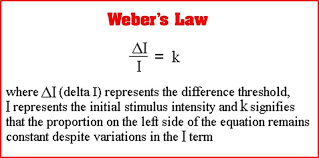W.B.C.S. Main 2018 Question Answer – Psychology -Fechners Law – Webers Law
A)Fechners Law
Fechner’s law states that the subjective sensation is proportional to the logarithm of the stimulus intensity. … The mathematical derivations of the torques on a simple beam balance produce a description that is strictly compatible with Weber’s law.
- Fechner woke up one day and realized there was a way to measure the magnitude of sensations.
- He built on the work of others who had been measuring stimulus thresholds (what is the weakest stimulus you can detect? what is the smallest difference in intensity between two stimuli that you can detecct?).
- Given the information on stimulus thresholds, Fechner realized there was an equation that would allow you to describe changes in the magnitude of psychological events (“How much sweeter is it now”) in terms of changes in the stimulus (“I’ll dissolve another teaspoon of sugar in the coffee.”)
- Sensation increases as the logrithm of stimulus intensity or “S = k log R”.
- So what you say? Well this is as revolutionary as E = mc2.
- Einstein’s equation says that energy and matter are interchangable. They are the same thing and you can convert a given amount of matter into a given amount of energy.
- Fechner’s law says mind (conscious experience) and matter (stimulus intensity) are the same thing as well.Fechner’s law argues that all jnds are the same perceived size.
- Fechner says, the 4 gm difference between 100 gm and 104 gm feels the same difference as the jnd of 40 gm between 1000 and 1040.
- Fechner is wrong–While those two differences are equally confusable, they don’t feel the same. The 40 gm difference feels larger.
-
Fechner’s Law Redux
- S = k log R
- Equal sensed differences are produced by equal stimulus ratios.
- The table illustrates the “log” relationship. Each stimulus is 8% larger than the one before.
- The figure shows that equal size steps in sensation are produced by stimuli that increase in a constant proportion (aka a geometic ratio).
B)Webers Law
Weber’s Law, more simply stated, says that the size of the just noticeable difference (i.e., delta I) is a constant proportion of the original stimulus value. …Weber’s Law can be applied to variety of sensory modalities (brightness, loudness, mass, line length, etc.).
Weber’s law, also called Weber-Fechner law, historically important psychological law quantifying the perception of change in a given stimulus. The law states that the change in a stimulus that will be just noticeable is a constant ratio of the original stimulus. It has been shown not to hold for extremes of stimulation.
The law was originally postulated to describe researches on weight lifting by the German physiologist Ernst Heinrich Weber in 1834 and was later applied to the measurement of sensation by Weber’s student Gustav Theodor Fechner, who went on to develop from the law the science of psychophysics. By stating a relationship between the spiritual and physical worlds, the law indicated to Fechner that there is really only one world, the spiritual. To others, the law meant the possibility of a scientific, quantitative psychology. The combined work of Weber and Fechner has been useful, especially in hearing and vision research, and has had an impact on attitude scaling and other testing and theoretical developments.
Observations About Weber’s Law
“Whether we can detect a change in the strength of a stimulus depends on the intensity of the original stimulus. For example, if you are holding a pebble (the original stimulus), you will notice an increase in weight if a second pebble is placed in your hand. But if you start off holding a very heavy rock (the original stimulus), you probably won’t detect an increase in weight when the same pebble is balanced on it. What Weber’s law underscores is that our psychological experience of sensation is relative. There is no simple, one-to-one correspondence between the objective characteristics of a physical stimulus, such as the weight of a pebble, and our psychological experience of it” (Hockenbury & Hockenbury, 2007).
Our own publications are available at our webstore (click here).
For Guidance of WBCS (Exe.) Etc. Preliminary , Main Exam and Interview, Study Mat, Mock Test, Guided by WBCS Gr A Officers , Online and Classroom, Call 9674493673, or mail us at – mailus@wbcsmadeeasy.in
Visit our you tube channel WBCSMadeEasy™ You tube Channel
Please subscribe here to get all future updates on this post/page/category/website



 Toll Free 1800 572 9282
Toll Free 1800 572 9282  mailus@wbcsmadeeasy.in
mailus@wbcsmadeeasy.in


















































































































